

19th August 2025 (18 Topics)
Mains Issues
Context:
India’s aquanauts successfully completed deep-sea dives up to 5000 metres, marking the nation’s first human mission into the deep ocean under the Samudrayaan Project of the Deep Ocean Mission.
Background and Significance
- Launched in September 2021 by Ministry of Earth Sciences (MoES).
- Outlay: ?4077 crore over 5 years.
- Aim: Develop technologies for sustainable harnessing of ocean resources – minerals, biodiversity, and energy.
- Strategic Vision: Strengthen Blue Economy, marine industries, and India’s role as a maritime power.
Major Components of Deep Ocean Mission 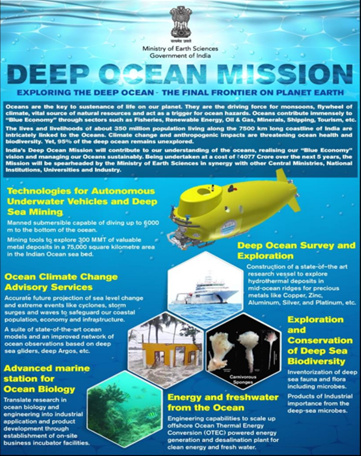
- Technological Innovations
- Manned Submersible (MATSYA 6000): 3-person capacity, depth up to 6000 m, 12-hour mission capability, 96-hour emergency endurance.
- Integrated Mining System: Extraction of polymetallic nodules from Central Indian Ocean.
- Advanced welding & safety systems developed indigenously with ISRO support.
- Climate and Ocean Services
- Development of an Ocean Climate Change Advisory Service for long-term modelling.
- Enhances understanding of seasonal-decadal climate variability.
- Biodiversity Exploration
- Bio-prospecting of deep-sea flora, fauna, microbes.
- Research for marine fisheries and allied services.
- Resource Survey and Energy Development
- Mapping of polymetallic nodules and hydrothermal sulphides.
- Ocean Thermal Energy Conversion (OTEC) studies for renewable power and desalination.
- Advanced Marine Station for Ocean Biology
- Incubation hub for marine biotechnology and industrial products.
- Promotes marine-based industries under Blue Economy.
Samudrayaan Project – India’s Deep-Sea Leap
- Core focus: Human Occupied Vehicle (HOV) – MATSYA 6000.
- Built with titanium-alloy pressure hull and electron-beam welding technology.
- Successful dry & wet trials at 500 m, and manned dives at 5000 m in collaboration with France’s IFREMER (2025).
- Milestone: Over 100 kg cobalt-rich polymetallic nodules collected in the Andaman Sea.
Strategic and Scientific Relevance
- Blue Economy
- India’s 7517 km coastline, 1382 islands, and 2.2 million sq. km EEZ provide vast opportunities.
- Blue Economy projected to cross $100 billion contribution.
- Global Context
- Only a handful of nations (USA, Russia, Japan, China, France) have deep-sea submersible technology.
- Strengthens India’s position in International Seabed Authority (ISA)
- Sustainability Concerns
- Need for balance between resource exploitation and conservation.
- Mission aligns with UN SDG-14: Life Below Water.
Challenges
- Technological: Extreme pressure (600 bar), temperatures (-3°C), reliability of manned submersibles.
- Environmental: Risk to fragile deep-sea ecosystems, biodiversity loss.
- Regulatory: International Seabed Authority (ISA) yet to finalise commercial mining framework.
- Financial & Human Resources: High cost, requirement of skilled aquanauts, and maintenance.
Way Forward
- Strengthen indigenous R&D in deep-sea engineering and biotechnology.
- Enhance international collaborations (e.g., India–France cooperation on IFREMER).
- Establish a National Framework for Deep-Sea Mining Governance with environmental safeguards.
- Integrate Blue Economy strategy with coastal livelihood promotion, marine tourism, and sustainable fisheries.
- Continuous impact assessments to ensure compliance with UNCLOS and ISA guidelines

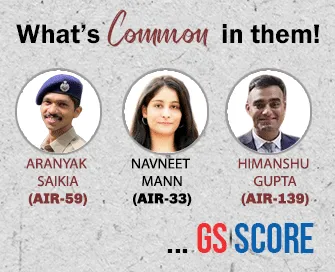
Prelims Articles
Context:
The Ministry of Culture has announced multiple digital initiatives for the preservation and promotion of manuscripts, artefacts, monuments, and performing arts, ensuring wider public access through technology.
Digitisation of Heritage and Manuscripts
- ASI’s NMMA Project: Digitally documented 1,18,359 antiquities and artefacts.
- Gyan Bharatam Mission: Digitised 3.5 lakh manuscripts in collaboration with 37 institutions.
- JATAN Software (by C-DAC Pune): Used for museum collection digitisation.
Archival and Audio-Visual Documentation
- AbhilekhPatal (NAI): Digital repository of historical documents and records.
- NCAA: Repository for rare and endangered cultural audio-visual recordings.
- Seven Zonal Cultural Centres (ZCCs): Located at Patiala, Prayagraj, Kolkata, Dimapur, Thanjavur, Nagpur, and Udaipur — working on documentation of performing and visual arts.
Digital Promotion Platforms and Cultural Integration
- Hampi Archaeological Museum Virtual App: Developed under National Culture Fund with AAI.
- National Virtual Library of India (NVLI): Provides multilingual digital access to cultural resources.
- Schemes include Kala Sanskriti Vikas Yojana (Guru-Shishya Parampara), National Mission on Manuscripts, and Cultural Mapping and Roadmap.

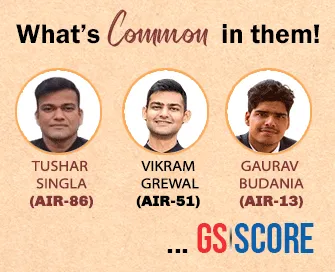
Prelims Articles
Context:
The INDIA bloc is considering moving a motion against Chief Election Commissioner (CEC).
Appointment and Removal of CEC and ECs
- The Chief Election Commissioner (CEC) and other Election Commissioners are appointed by the President.
- Removal of CEC: Same process as removal of a Supreme Court judge, i.e., by Parliament on grounds of proved misbehaviour or incapacity.
- Other Election Commissioners: Can be removed by the President on the recommendation of the CEC.
Chief Election Commissioner and Other Election Commissioners (Appointment, Conditions of Service and Term of Office) Act, 2023
- Provides for a selection committee headed by the Prime Minister, with the Leader of Opposition in Lok Sabha and a Union Cabinet Minister as members.
- Grants immunity to CEC and ECs for all decisions taken in present and past, shielding them from legal proceedings.
- Fixes their term at six years or until the age of 65 years, whichever is earlier.
Constitutional and Legal Safeguards
- Article 324 of the Constitution vests the superintendence, direction, and control of elections in the Election Commission.
- The Election Commission of India (ECI) is a constitutional body, ensuring independence in conduct of free and fair elections.
- Any motion against the CEC is politically significant but legally bound by strict constitutional provisions.


Prelims Articles
Context:
The Union Minister for Commerce and Industry introduced the Jan Vishwas (Amendment of Provisions) Bill, 2025 in Lok Sabha, expanding the scope of decriminalisation to promote ease of doing business and ease of living.
Jan Vishwas Initiative
- The Jan Vishwas Act, 2023 was the first consolidated legislation to decriminalise minor offences across multiple Acts.
- It decriminalised183 provisions in 42 Central Acts administered by 19 Ministries/Departments.
Salient Features of the 2025 Bill
- Covers 16 Central Acts under 10 Ministries/Departments.
- Proposes 355 amendments, including 288 decriminalisations and 67 amendments for ease of living.
- Replaces imprisonment for technical or procedural defaults with monetary penalties or warnings.
Penalty and Enforcement Mechanisms
- First-time contraventions: Only advisory or warning for 76 offences.
- Graduated penalties: Higher fines for repeated violations.
- Adjudication mechanism: Designated officers empowered to impose penalties, reducing judicial burden.
- Automatic penalty revision: Fines to increase by 10% every three years.
Acts Under Focus
- Further amendments proposed in Tea Act, 1953; Legal Metrology Act, 2009; Motor Vehicles Act, 1988; Drugs and Cosmetics Act, 1940, all previously covered under Jan Vishwas Act, 2023.
- Ease of Living focus includes NDMC Act, 1994 and Motor Vehicles Act, 1988.


Prelims Articles
Context:
The Union Home Ministry has submitted before the J&K and Ladakh High Court that the Lieutenant Governor (LG) of J&K can nominate five members to the Legislative Assembly without the aid and advice of the Council of Ministers.
Constitutional & Statutory Provisions
- The Indian Constitution provides for nominated members in Lok Sabha (earlier Anglo-Indians, discontinued in 2020), Rajya Sabha (12 nominated by President), and in Legislative Councils of States (1/6th nominated by Governors).
- Section 14, J&K Reorganisation Act, 2019 (amended 2023) ? 90 elected seats in J&K Assembly.
- Sections 15, 15A, 15B ? LG may nominate up to five members (2 women, 2 Kashmiri migrants, 1 displaced from PoK).
Judicial Standpoints
- Lakshminarayanan vs Union of India (2018, Madras HC): Union Govt. can nominate MLAs to Puducherry without UT Council of Ministers’ advice. (SC later set aside recommendations for statutory clarity).
- GNCTD vs Union of India (2023, SC): Laid down the principle of “triple chain of accountability” ? LG bound by aid & advice of Council of Ministers, except in reserved matters.
Federal & Democratic Concerns
- Union Territories (UTs) with legislatures (Delhi, Puducherry, J&K) have elected governments accountable to people.
- Political differences between Centre and UT governments may distort the democratic mandate if nominated MLAs alter Assembly majorities.
- J&K is a sui generis case ? former State with special autonomy till 2019, now a UT with promise of statehood restoration.


Prelims Articles
Context:
Rashtriya Ayurveda Vidyapeeth, Ministry of Ayush hosts 30th National Seminar on Paediatric Health
Institutional Framework:
- Rashtriya Ayurveda Vidyapeeth (RAV) is an autonomous organization under the Ministry of Ayush, Government of India.
- Established in 1988, its objective is to revive classical Ayurvedic textual and practical knowledge through the Gurukula system of learning.
Training Programmes:
- CRAV (Certificate of RAV) and MRAV (Member of RAV) are key courses.
- To strengthen diagnostic skills of Ayurveda teachers, 19 training programmes on classical diagnostic methods were conducted till 2022-23.
Nodal Role in CME:
- RAV also serves as the nodal agency for the Central Sector Scheme of Continuing Medical Education (CME).

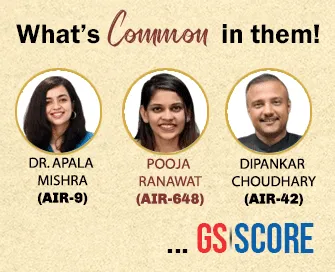
Prelims Articles
Context:
The Government has outlined the criteria and verification process for declaring villages as ODF Plus under Swachh Bharat Mission (Grameen), Phase-II.
ODF Plus Village
- A village that sustains its Open Defecation Free (ODF) status, ensures solid and liquid waste management, and maintains visual cleanliness.
Stages of ODF Plus
- ODF Plus Aspiring: ODF status + Solid Waste Management OR Liquid Waste Management.
- ODF Plus Rising: ODF status + both Solid and Liquid Waste Management.
- ODF Plus Model: ODF status + both SWM & LWM + visual cleanliness (minimal litter, no stagnant water, no plastic dumps) + IEC displays.
Declaration and Verification
- Villages self-declare ODF Plus in Gram Sabha.
- Mandatory third-party verification within 90 days only for ODF Plus Model
- Supervisory verification may be conducted at Aspiring, Rising, and Model levels by Block/District/State officers.
Implementation Framework
- Sanitation is a State subject; Centre provides financial and technical support.
- SBM(G) Phase-II (2020–21 to 2025–26) focuses on:
- Sustaining ODF status.
- Universal coverage with solid & liquid waste management.
- Construction of new toilets for emerging and migrant households.
Significance
- Moves focus beyond mere toilet construction towards sustainability and cleanliness.
- Integrates waste management, community monitoring, and visual cleanliness.
- Strengthens rural sanitation as a continuous and evolving process


Prelims Articles
Context:
The Government of India launched the NAVYA (Nurturing Aspirations through Vocational Training for Young Adolescent Girls) initiative to empower girls aged 16–18 years through skill development in emerging and non-traditional sectors.
Institutional Framework:
- Joint initiative of the Ministry of Skill Development & Entrepreneurship (MSDE) and the Ministry of Women & Child Development (MWCD).
- Implemented under the umbrella of Pradhan Mantri Kaushal Vikas Yojana 4.0 (PMKVY 4.0).
Coverage and Target Group:
- Targets adolescent girls aged 16–18 years in aspirational districts.
- Current coverage:19 States and 27 districts.
- Planned training for 3,850 girls in the pilot phase.
Objectives:
- Provide demand-driven vocational training aligned with both traditional and modern sectors.
- Ensure holistic development through modules on health, nutrition, hygiene, life skills, financial literacy, and legal awareness.
- Promote employability, entrepreneurship, and forward linkages (internships, apprenticeships, job placements).
- Create a safe, gender-inclusive training environment.
- Bridge education-livelihood gaps for underserved communities.


Prelims Articles
Context:
The Karnataka High Court upheld that the POCSO Act, 2012, is gender-neutral and refused to quash a criminal case against a woman accused of sexually assaulting a minor boy.
Protection of Children from Sexual Offences (POCSO) Act, 2012
About
- Enforced on 14 November 2012 after India ratified UN Convention on the Rights of the Child (1992).
- Defines child = person below 18 years.
- Objective: To specifically address sexual exploitation and abuse of children.
- Amendment 2019 ? Introduced stringent punishments (including death penalty) for aggravated sexual offences.
- POCSO Rules, 2020 notified for victim-centric relief and support.
Key Features
- Gender-Neutral Law – Applies to all children (boys & girls) and any perpetrator.
- Comprehensive Offence Definitions – Includes penetrative assault, non-penetrative assault, sexual harassment, and child pornography.
- Mandatory Reporting – Non-reporting is a punishable offence.
- Punishments – Proportional to gravity; minimum sentences enhanced after 2019 amendment.
- Child-Friendly Procedures – In-camera trial, no aggressive questioning, police to record statement in plain clothes.
POCSO Rules, 2020
- Rule 9: Interim Compensation for child’s relief/rehabilitation (adjusted with final compensation).
- Immediate Relief: CWC may recommend essentials (food, clothes, transport) through DLSA/DCPU/JJ Act funds (payment within 7 days).
- Support Person: Appointed to assist the child during investigation & trial (ensuring physical, emotional, educational support).
Judicial Standpoint
- The High Court clarified that the traditional notion of only men being “active participants” in sexual assault is archaic.
- Sections 3, 4, and 6 define penetrative sexual assault and aggravated penetrative sexual assault, applicable to any person committing such acts against a child (below 18 years).
- The judgment reinforces progressive interpretation, ensuring accountability of women also in cases of child sexual abuse.
Legal Implication
- Under Section 4, punishment for penetrative sexual assault is imprisonment of not less than 10 years, extendable to life, and fine.
- Section 6 prescribes stricter punishment for aggravated cases (20 years to life imprisonment).
Constitutional and Legal Significance
- Ensures equality before law under Article 14 and protection of children’s rights under Article 21.
- Strengthens India’s commitment to UN Convention on the Rights of the Child (UNCRC), ratified in 1992.


Prelims Articles
Context:
S&P Global upgraded India’s long-term sovereign credit rating from ‘BBB-’ to ‘BBB’ (investment grade), the first such upgrade after 18 years, citing robust growth, fiscal consolidation, and controlled inflation.
About S&P Global
- One of the three major international credit rating agencies (along with Moody’s and Fitch).
- Provides sovereign and corporate credit ratings to assess risk and creditworthiness.
India’s New Sovereign Rating
- Long-term rating: Upgraded to ‘BBB’ (investment grade).
- Short-term rating: Upgraded to ‘A-2’.
- Transfer and convertibility assessment: Upgraded to ‘A-’ from ‘BBB+’.
Implications of ‘BBB’ Rating
- Indicates adequate capacity to meet financial commitments, though sensitive to external shocks.
- Boosts investor confidence, lowers sovereign borrowing costs, and improves India’s global financial image.
Key Drivers of Upgrade
- Strong Economic Growth:
- Real GDP growth averaged 8% (FY22–FY24); projected at 6.8% annually for next three years.
- Fiscal Stability:
- Central fiscal deficit projected to fall from 8% (FY25) to 4.4% (FY26).
- General government deficit to decline from 3% (FY26) to 6.6% (FY29).
- Controlled Inflation:
- CPI inflation averaged 5% over past 3 years.
- Recently declined to 6% in July 2025, within RBI’s 2–6% target band.
- Monetary Policy:
- RBI cut repo rate to 5% in Feb 2025, citing easing inflation.
- External Stability:
- Current account deficit remains modest, rupee depreciation aiding exports, net external asset balance stable.


Prelims Articles
Context:
On 18 August 2025, the Government of India launched the Made in India Label Scheme with an allocation of ?995 crore for three years, introducing QR-coded labels to authenticate Indian products and strengthen their identity in domestic and global markets.
About the Scheme
- Voluntary certification scheme led by DPIIT with support from Quality Council of India (QCI) and India Brand Equity Foundation (IBEF).
- Provides a QR-coded label displaying details of product origin, location of manufacturing, validity, and product-specific information.
- Covers manufacturers and producers who wholly or substantially manufacture/assemble products in India.
Eligibility & Certification
- Minimum 50% value addition criteria, with exceptions allowed after industry consultations.
- Manufacturers must apply online, undergo verification, and receive approval before label use.
Objectives
- Build trust and authenticity of Indian products.
- Enhance India’s global competitiveness by improving quality perception.
- Promote Atmanirbhar Bharat and “Vocal for Local” campaigns.
- Strengthen domestic industries, including MSMEs, textiles, steel, electronics, agriculture, fisheries, and allied sectors.
Global Context
- India ranked 10th in the Global Quality Infrastructure Index (GQII) 2023, reflecting strong metrology, standardisation, and accreditation systems.
- The scheme aims to leverage this standing for building an international Brand India.
Pilot and Sectoral Initiatives
- Steel (2023): First sector to adopt Made in India branding.
- Textiles (2024): MoU signed between QCI and KVIC for MSME integration.
- Electronics: QR codes made mandatory under Legal Metrology (Packaged Commodities) Rules, 2011 amendments.


Prelims Articles
Context:
As of July 2025, over 25 crore Soil Health Cards have been distributed to farmers across India, supported by 8,272 soil testing labs and digital upgrades like GIS mapping and QR-coded SHC mobile app.
About the Scheme
- Launched:19 February 2015 at Suratgarh, Rajasthan.
- Objective: To assess soil nutrient status and provide recommendations every two years.
- Since 2022–23, merged with Rashtriya Krishi Vikas Yojana (RKVY) under the component “Soil Health & Fertility”.
Features of Soil Health Card (SHC) 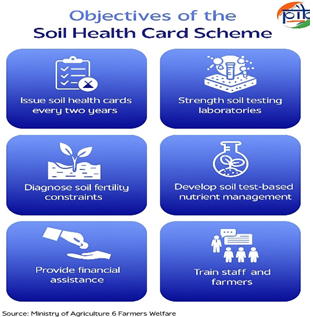
- Printed/digital report covering 12 key parameters:
- Macro-nutrients: N, P, K, S.
- Micro-nutrients: Zn, Fe, Cu, Mn, B.
- Other indicators: pH, EC, OC.
- Suggests use of fertilisers, bio-fertilisers, organic inputs, and soil treatments.
- Validity:3 years.
Implementation Infrastructure
- ?1,706 crore released (till Feb 2025).
- 8,272 labs: 1,068 static, 163 mobile, 6,376 mini, 665 village-level labs.
- Soil mapping: 290 lakh hectares in 40 aspirational districts.
- Village-level fertility maps: 1,987 prepared in 21 States/UTs.
Innovations
- Digital SHC Portal & Mobile App (NIC-developed): QR-code linked, GPS-based soil sampling, GIS integration, real-time lab uploads.
- School Soil Health Programme: Labs in 1,021 schools, 1,32,525 students engaged in soil testing and farmer awareness.
- Village Level Soil Testing Labs (VLSTLs): Opened to rural youth, SHGs, FPOs.
Benefits & Impact
- Promotes balanced fertiliser use, reduces input costs, improves yields (e.g., Bihar farmer case study: 16% yield increase).
- Builds farmer awareness and improves long-term soil fertility.
- Encourages climate-resilient agriculture and sustainable resource management.


Prelims Articles
Context:
The Ministry of Environment, Forest and Climate Change has notified the Environment Protection (Management of Contaminated Sites) Rules, 2025 to regulate identification, assessment, and remediation of contaminated sites.
Definition of Contaminated Site
- An area declared contaminated by the SPCB/PCC if contaminants exceed prescribed threshold levels after detailed assessment.
Identification Process
- Local bodies/District Administration must list suspected contaminated sites on a centralised online portal.
- SPCB/PCC conducts preliminary assessment within 90 days ? if above screening levels ? site marked as probable contaminated site.
- Detailed assessment within 3 months ? if above response levels ? declared as contaminated site.
Public Participation and Transparency
- List of contaminated sites published on the portal.
- Stakeholder comments invited within 60 days.
- Final list published along with public notices in two local newspapers.
Remediation Responsibility
- Responsible person must prepare and implement a remediation plan within six months.
- Progress reports submitted to CPCB and SPCB/PCC.
- For orphan sites or disputed sites (banks/judicial proceedings), SPCB/PCC prepares the plan; costs shared by Central & State Governments.
Current Status (as per CPCB)
- 103 contaminated sites identified across India.
- Remediation initiated at 7 sites (Odisha, UP, Tamil Nadu, Maharashtra, Gujarat).


Prelims Articles
Context:
A recent study by the Indian Institute of Science (IISc) has uncovered how glucose transporter proteins malfunction in Type-2 diabetes, offering potential new therapeutic targets.
Role of Pancreatic Beta Cells
- Beta cells in the pancreas regulate blood glucose by secreting insulin in response to glucose uptake.
- Insulin facilitates glucose absorption into tissues, lowering blood sugar levels.
Glucose Transporters (GLUTs)
- Proteins that mediate glucose entry into beta cells.
- In humans, GLUT1 is the main transporter; in mice, it is GLUT2.
- Transporters move to the beta cell surface during high glucose levels, enabling uptake and triggering insulin release.
New IISc Findings
- The study highlights that in Type-2 diabetes, the cycling of GLUT transporters to the cell surface is disrupted.
- This malfunction impairs glucose entry into beta cells, reducing insulin release.
- Research used live-cell imaging to track GLUT1 and GLUT2 dynamics.
Therapeutic Significance
- By targeting the pre-entry stage of glucose (before it enters beta cells), new drug interventions may be designed.
- Understanding clathrin-mediated endocytosis (the process of GLUT cycling) opens avenues for therapeutic corrections in Type-2 diabetes.
|
Type 1 and Type 2 Diabetes Type 1 Diabetes:
Type 2 Diabetes:
|


Prelims Articles
Context:
The Health department in BENGALURU Kerala’s Kozhikode has issued an alert against primary amoebic meningoencephalitis (PAM) in the district in view of the reporting of three cases of the infection and a death in recent days.
PAM (Primary Amoebic Meningoencephalitis)
Causative Organism – Naegleria fowleri
- Naegleria fowleri is a free-living amoeba, commonly known as the "brain-eating amoeba."
- It thrives in warm freshwater bodies such as lakes, rivers, and poorly maintained swimming pools.
- It is thermophilic (heat-loving) and can survive at temperatures up to 46°C, making global warming a potential risk factor for its spread.
- It does not survive in salty water (seawater) and chlorinated pools with proper disinfection.
Mode of Transmission
- The amoeba infects humans when contaminated water enters the nasal cavity, typically during swimming, diving, or water sports.
- From the nasal passages, it migrates along the olfactory nerve to the brain.
- It is not transmitted person-to-person, making it a non-communicable disease.
Pathogenesis and Fatality
- Once in the brain, Naegleria fowleri rapidly destroys brain tissue, causing inflammation and swelling.
- The disease progresses extremely fast: early flu-like symptoms advance to neurological dysfunction, coma, and death within days.
- The case fatality rate is over 97%, with only a handful of survivors reported worldwide.
Treatment Protocols
- There is no universally effective treatment. Most cases remain fatal despite interventions.
- Current management follows CDC guidelines, using a combination therapy of drugs such as:
- Amphotericin B (antifungal, primary drug)
- Miltefosine (antiparasitic, recently used with some success)
- Azithromycin, Fluconazole, Rifampin, and Dexamethasone (as adjunct therapies).
- Some rare survivors were treated with early diagnosis, aggressive drug therapy, and induced hypothermia.


Editorials
Context:
Prime Minister Modi’s Independence Day address outlined a comprehensive roadmap for India’s economic reforms, focusing on energy security, employment, taxation, and industrial growth.
Economic and Fiscal Reforms
- Tax Simplification: The replacement of the Income Tax Act, 1961 with a new Income Tax Bill aims to reduce complexity by abolishing 280 redundant sections and offering relief up to ?12 lakh.
- GST 2.0 and Faceless Assessment: The introduction of GST 2.0 and the faceless assessment mechanism have made the tax system more transparent, efficient, and incorruptible.
- Rationalisation of Laws: Over 40,000 compliance norms and 1,500 outdated laws have been abolished, reflecting a shift towards ease of doing business and dismantling outdated Nehruvian economic legacies.
Energy Security and Industrial Growth
- Energy Independence Goal: India is working towards energy independence by 2047, with measures such as expanded exploration policies, biofuel blending, and increased domestic production of oil and gas.
- Renewable and Green Energy Push: Policies promoting solar, wind, ethanol, and green hydrogen are intended to reduce fossil-fuel dependence and strengthen energy resilience.
- Building an Industrial Base: India is scaling up initiatives like PLI (Production Linked Incentives), semiconductor manufacturing, and the establishment of a new rail-industrial corridor, aiming at long-term industrial self-reliance.
Strategic and Social Dimensions
- Defence and Geopolitical Role: India is expanding its defence production under Atmanirbhar Bharat, with domestic manufacturing of aircraft carriers, fighter jets, and missile systems to reduce reliance on imports.
- Social Welfare and Healthcare: Schemes such as PM Ayushman Bharat Health Infrastructure Mission and improved pharmaceutical production strengthen healthcare access and India’s role as a global vaccine hub.
- Employment and Future Roadmap: With a focus on digital innovation, skilling, and manufacturing, the reforms target employment creation while ensuring India’s emergence as a global growth driver by 2047.
Practice Question
“The recent Independence Day address by the Prime Minister laid down a comprehensive charter of reforms covering taxation, energy, defence, and industrial policy. Critically analyse how these initiatives reflect India’s vision of self-reliance and global leadership by 2047.” (250 words)


Editorials
Context:
The UN State of Food Security and Nutrition in the World 2025 Report highlights India’s decisive role in reducing global undernourishment, with national hunger prevalence declining to 12% in 2022–24.
Decline in Undernourishment
- Global Progress: Undernourishment fell globally to 673 million people (8.2%) in 2024, marking a reversal of the pandemic-induced spike.
- India’s Contribution: India reduced undernourishment from 3% (2020–22) to 12% (2022–24), translating into 30 million fewer people facing hunger.
- Role of Food Security Policies: Policy investments in digital governance, targeted delivery, and nutrition-sensitive programs underpinned these improvements.
Transformation of India’s Food Systems
- Public Distribution System (PDS) Modernisation: Digitisation, Aadhaar-enabled authentication, real-time tracking, and One Nation One Ration Card enabled food portability for 800 million people.
- Nutrition-Focused Schemes: Schemes such as PM POSHAN and ICDS have shifted focus from calorie sufficiency to dietary diversity and child nutrition.
- Persistent Challenges; Despite progress, over 60% of Indians cannot afford a healthy diet due to high prices of nutrient-dense foods and inadequate cold chains.
The Road Ahead for Agrifood Transformation
- Boosting Nutritious Food Supply: Expanding production and affordability of pulses, fruits, vegetables, and animal-source foods is essential for balanced nutrition.
- Infrastructure and Women’s Role: Investments in cold chains, digital logistics, and support for FPOs and women-led enterprises can reduce food loss and enhance livelihoods.
- Global Leadership: Through innovations like AgriStack, e-NAM, and data-driven agriculture, India can guide other developing nations in meeting SDG-2: Zero Hunger.
Practice Question
“India’s recent achievements in reducing hunger reflect a major transformation in food governance. Critically examine how India can shift from ensuring food security to achieving nutrition security, while also contributing to global agrifood system transformation.”


Editorials
Context:
The Alaska Moment between U.S. President Donald Trump and Russian President Vladimir Putin raised expectations for India regarding sanctions relief and trade, but the summit produced limited benefits for New Delhi.
India’s Hopes and U.S. Responses
- Expectations from the Summit: India expected the U.S.-Russia rapprochement to ease American pressure on New Delhi’s relations with Moscow, particularly in oil imports and trade negotiations.
- S. Sanctions Pressure: Instead of relief, the U.S. reiterated its plan for 25% secondary sanctions on Indian imports of Russian oil, along with maintaining 25% reciprocal tariffs on Indian exports.
- Divergent Narratives on Operation Sindoor: President Trump claimed to have mediated the India-Pakistan ceasefire in May 2025, contradicting the Modi government’s narrative and further straining bilateral trust.
Structural Lessons for India’s Foreign Policy
- Summitry vs. Substance: India’s over-reliance on leader-level diplomacy has yielded limited strategic gains, as seen in the contrast between high-profile summits and unresolved disputes with both the U.S. and China.
- Institutional Weakness in Engagement: Decision-making under President Trump remains highly personalized, with few institutional channels available for India to negotiate effectively.
- Need for Senior-Level U.S. Representation: The absence of a senior U.S. envoy with deep knowledge of India complicates navigation through turbulent phases of the bilateral relationship.
Strategic Course Correction for India
- Bipartisan Engagement in U.S. Politics: India must reclaim bipartisan credibility in the U.S. by balancing ties with Republicans and Democrats, avoiding over-association with one political faction.
- Upholding Strategic Autonomy: New Delhi’s past acceptance of unilateral U.S. sanctions (e.g., Iran, Venezuela) weakened its principles; resisting such pressures strengthens its credibility in the Global South.
- Countermeasures Against Adverse Policies: India must explore reciprocal and calibrated responses to U.S. tariff barriers, remittance taxes, and trade restrictions to safeguard its economic and strategic interests.
Practice Question
“The Alaska Summit of 2025 has highlighted the fragility of India-U.S. ties under shifting global power dynamics. Critically analyse the lessons for India’s foreign policy in balancing strategic autonomy, economic interests, and great power relation (250 words)




